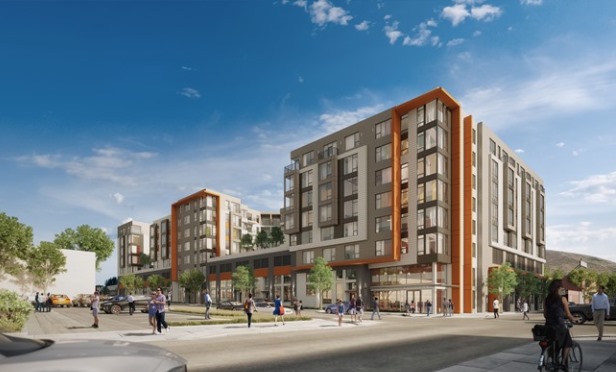 Located at 200 to 216 Miller Ave., the combined lots will accommodate 195 units on 1.08 acres.
Located at 200 to 216 Miller Ave., the combined lots will accommodate 195 units on 1.08 acres.
SOUTH SAN FRANCISCO—San Mateo-based Sares Regis Group of Northern California has closed escrow on five parcels adjacent to the new Cadence multifamily community for an upcoming second phase of the project. The project was approved as part of a multiphase development agreement with the city of South San Francisco that began in 2015.
Located at 200 to 216 Miller Ave., the combined lots will accommodate 195 units on 1.08 acres. Due to existing lease commitments on the recently acquired parcels, plans call for construction to begin in the Fall 2020 with completion in 2022.
"We are excited to expand on Cadence and bring more much-needed new housing to downtown South San Francisco in a walkable neighborhood," says Ken Busch, senior vice president for Sares Regis. "This new phase will give downtown South San Francisco several hundred new residents who will shop and eat at Grand Avenue businesses, and increase use of the nearby Caltrain station currently being upgraded."
The development will match the existing height of the project's first phase and bring the total number of new homes offered by Sares Regis in South San Francisco to 455. Residents will have access to new amenities located in the Phase II building, as well as use of Cadence Phase I's amenities, which include a rooftop lounge overlooking San Bruno Mountain, specialized fitness center, maker space, dog wash, outdoor terrace, club rooms and landscaped courtyards.
The Cadence Phase II project will include additional streetscape improvements on Miller and Cypress Avenues including enhanced paving, furniture, street trees, lighting and bicycle improvements. Leasing and management will be coordinated from the recently opened leasing center in Cadence Phase I.
"New housing has been one of South San Francisco's top priorities in recent years and this project complements Cadence I in going a long way towards helping us meet our urgent housing needs," says city manager Mike Futrell. "Its close proximity to both Caltrain and Grand Avenue will help support a vibrant successful downtown for our many merchants and restaurateurs."
The overall architectural design by San Francisco-based BDE Architects aims to enliven the streetscape along Miller and Cypress Avenues to promote walkability and connect the neighborhood. While it is similar in scale and complementary in style to the existing Phase I buildings, the Phase II building charts its own architectural expression. This development looks to create a sense of community, encourage pedestrian traffic, and promote visual connectivity between Miller Avenue and its surroundings.
"With residents moving into the first phase of Cadence, downtown South San Francisco is starting to see the benefits of this new community just a short walk from Grand Avenue," Busch tells GlobeSt.com. "We look forward to bringing an additional 195 new apartments to the area that will contribute to keeping the neighborhood successful and vibrant."
Cadence Phase II will be constructed with union labor.
"The building trades are pleased to be in partnership with Sares Regis to build the second phase of Cadence," said James Ruigomez, spokesman for the San Mateo County Building and Construction Trade Council. "Sares Regis has committed to hiring workers that are paid a working-class wage with benefits."
Housing prices and rents in the county are on the rise and San Mateo County has some of the highest housing costs in the nation. Increased property values may be welcome news for many current homeowners, but for first-time buyers or people relocating to the area, it only exacerbates the difficulty of purchasing a home in the county, according to Sustainable San Mateo.
A lack of affordable housing limits the ability of people to live in the county and can reduce the availability of qualified workers for local jobs, thereby constraining economic growth. In response to high housing prices, many workers are forced to either live outside the county and face long commutes or stretch themselves financially and pay more than they really can afford for housing. Sustainable San Mateo says approximately 60% of those employed in San Mateo County commute in from other counties for work, which leads to increased traffic congestion and vehicle-related emissions.
© Touchpoint Markets, All Rights Reserved. Request academic re-use from www.copyright.com. All other uses, submit a request to [email protected]. For more inforrmation visit Asset & Logo Licensing.







